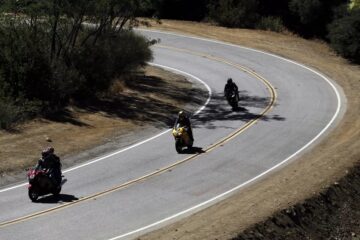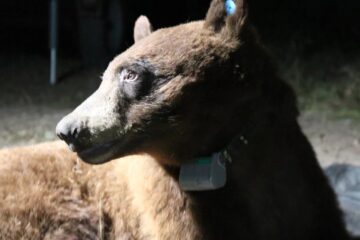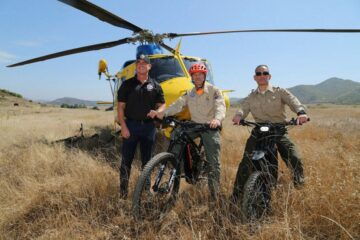FITNESS: Mountain bikers’ dark streak
Cyclists are heading out after sunset for reasons both practical (schedules) and personal (sensory rush).
Source of this article – Los Angeles Times, April 3, 2006.
By Bill Becher. Special to The Times

ILLUMINATED: Handlebar lamps light the way for riders on a mountain trail. Advances in lighting systems have contributed to the growing number of night cyclists. Research varies on the link of late-night exercising to sleep problems.
THE darkening sky glows red as a long line of lights bobs along the dirt road. Riders breathe hard as they pedal their mountain bikes four miles up the Verdugo Mountains in Glendale. City lights twinkle below in the cold night air. It is 6:30 p.m., and the San Fernando Valley-based Over the Bars Mountain Bike Club is out on its twice-weekly night ride.
“It’s addictive,” says club member Ed Daniels of Downey. “It’s an adrenaline rush.”
Whether they’re accommodating busy lives, avoiding summer heat or seeking the rush that comes from riding in the dark, more mountain bikers are strapping on high-tech lights and hitting the trail after dusk.
“The main reason people ride at night is their schedule,” says Mark Langton, who teaches mountain biking skills and has written guides to local trails. “They have to get their fix in after work.”
Yet there is an allure to night riding that goes beyond the practical.
Riders say senses are heightened and even familiar trails seem different in the dark. Some have seen mountain lions and bears on rides, and many see deer and coyotes. On one night ride, Langston watched an owl fly out of a tree. “You could look up and see his wings going over,” he says. “That was a unique experience you wouldn’t have if you only ride during the day.”
The mountains surrounding the L.A. Basin are dotted with prime locations for a night ride.
Though some parklands close at dusk, national forest and Santa Monica Mountains National Recreation Area trails are usually open 24 hours. Cheeseboro and Palo Comado canyons in Agoura Hills, popular with mountain bikers, have been closed at night since last fall’s Topanga fire to protect sensitive areas that are still recovering from the fire, says Woody Smeck, superintendent of the recreation area.
Smeck says riding and hiking at night are unique ways to experience the park.
“It can be serene at night — so quiet and peaceful you wouldn’t know you were near L.A.,” he says.
Not everyone is so enthusiastic. For years, experts have warned against exercising too close to bedtime because it raises body temperature and may interfere with sleep. Because of this, the National Sleep Foundation advises exercising at least three hours before you plan on going to bed or waiting until morning.
But some scientists don’t find the sleep disturbance link. “In my research, exercising very vigorously ending a half-hour before bedtime did not impair sleep,” says Shawn Youngstedt, an assistant professor of exercise science at the University of South Carolina in Columbia. Youngstedt thinks such advice creates an unnecessary barrier to exercise for those with a busy schedule.
Dr. Anne McTiernan, director of the Prevention Center at the Fred Hutchinson Cancer Research Center in Seattle, has reported that middle-aged women who exercise at night have more difficulty falling asleep than a non-exercising control group or those who work out in the morning.
But McTiernan says she thinks the benefits of exercise outweigh any risk of sleep problems.
Then there’s the question of safety.
Jim Hasenauer of the International Mountain Bicycling Assn., an advocacy group, says riding at night is no more dangerous than riding during the day because most cyclists go slower at night.
Still, to be safe, Hasenauer suggests night riders take a backup light, cellphone, extra layers of clothing, water, some food and even a small reflective emergency blanket.
Night riders also need to make sure they can see where they’re going. Most use bike lights that employ the same high intensity discharge, or HID, technology that’s found in the headlights on some European automobiles. These bright, bluish lights use about one-quarter of the battery power of older halogen models, says Mike Ely, sales manager for NiteRider Technical Lighting Systems in San Diego. Some riders use two lights, one on the handlebars and one mounted on their helmets.
Today’s HID lights are lighter and last longer because of advances in rechargeable battery technology, which are driven by demands for lighter, more powerful batteries in laptop computers and cellphones.
But the improvements don’t come cheap. HID lights start at about $300 and can cost more than $500 for more powerful models lasting up to 12 hours.
The nighttime ride up the steep trail takes 14 Over the Bars riders 45 minutes. At the top of the climb they stop and gulp water, joke around with each other and admire the 360-degree view.
A recent rain has brought out the spicy scent of the chaparral, and, except for the lights below, the city feels very far away.
The riders peel off jerseys soaked in sweat and don dry clothing for the quick, chilling ride down the hill.
Then it’s home, hopefully for a good night’s sleep.
No need to ride alone at night
You can find out more about night mountain bike rides in Southern California at the following websites:
• Over the Bars Mountain Bike Club leads night bicycle rides on Tuesdays and Thursdays. Details are at otbmbc.com
• South Bay Mountain Biking Club sponsors weeknight rides in the Santa Monica Mountains, San Fernando Valley and Palos Verdes Peninsula. Information is at sbmbc.com.
• North Ranch Mountain Bikers ride at night in the Thousand Oaks and San Fernando Valley areas. See http://www.nrmbc.org/



